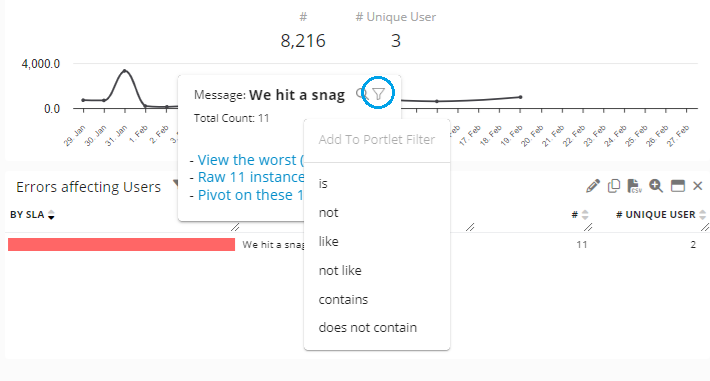Error Monitoring for SAP (Configure)
Features
Guide to configuring the analysis of impactful errors and filtering out the insignificant ones to SAP Users or Business Processes. Ignore the noise and focus on the issues that are critical to your business! Germain has the ability to help you understand the impact, at scale, of any errors on the end-user or business operations while operating with SAP. It helps separate critical errors from benign ones and also identifies the new ones.
This assumes you have already deployed Germain UX - RUM JS and Germain UX - Engine for your SAP instance.
User Error Tagging/Monitoring for SAP
Here is how to configure Germain UX’s monitoring identify errors that affect SAP users.
Configure UX Monitoring Profile
Germain Workspace > Left Menu > Analytics > UX Monitoring Profiles > SAP OpenUI
Application Error Tagging for SAP Application
Here is how to map all SAP custom error codes to their corresponding display messages visible to your end users. To configure this mapping, please follow the steps below:
Extract all of your SAP Error codes using
errmsg.exeSAP’s utility (available only on Windows platforms). SAP keeps these codes in the resource catalogs (core.cat, apps.cat, vsia.cat, inst.cat, …) in the %SAP_ROOT%\bin\%language_folder%. Example below shows how to extract these codes from SAP resource catalog in English language format:CODE%SAP_ROOT%\bin\errmsg.exe /l ENU enu\core.cat > errors.txtReview
errors.txtoutput file and find all of your custom errors, e.g.CODE... SBL-GEN-02011 Error parsing SAP message file header: incorrect facility name ...Once all custom error code extracted from the
errors.txtfile, insert them intoSAP_ERROR_CODE_MAPPINGtable available in your Germain UX Datastore. Example below for MySQL database:
INSERT INTO SAP_ERROR_CODE_MAPPING (CODE,MESSAGE) VALUES ('SBL-GEN-02011','Error parsing SAP message file header: incorrect facility name');Alert and/or Report
Here is how to be alerted immediately when a new error occurs or receive automatic report to help understand error volume, up and down trends.
Visualize & Analyze SAP Errors
Here is how to build analytics on Errors of SAP.
Add a portlet and set it up as following:
KPIs (any catching errors such as):
”SAP JavaScript Popup Dialog” (primarily)
“Browser Event”
”Javascript Console Event”
”Outbound Http Request”
(or any other KPI you have created in conjunction to monitoring errors).
Measures:
“Count”, “Count Unique User”, etc
Pivots:
”Name” or ”Message”
(depending on the KPI)
Filters:
”User Error” = “true” or “userError” = “true “
(depending the version of GermainUX you are on)
Exclude Errors
If you still need to ignore/exclude some of the errors that show up, set a filter as following:
Filter in or out specific SAP errors - Germain UX
SAP error codes to monitor (may not apply to all environments)
Category 1: High Impact, Frequent Errors
These often break core business processes, generate short dumps, or block user activity.
Error Code | Description | Impact | Frequency | GermainUX Detection / Prevention |
|---|---|---|---|---|
| Memory allocation error | Critical – causes dumps | Frequent in data-heavy processes | Monitor memory usage per transaction; auto-alert when thresholds are crossed |
| SQL error in Open SQL | High – can corrupt or block processes | Common in custom reports | Track DB execution time/errors; correlate with business KPIs |
| No roll memory | Critical – halts transactions | Moderate | Monitor user session memory usage in real-time |
| Update task failed | High – data loss risk | Frequent in poorly coded Z programs | Correlate update failures with user actions and transaction codes |
| Null pointer | High – ABAP dump | Frequent in custom code | Highlight failing ABAP objects in business context (e.g. Order creation) |
| RFC destination unreachable | High – integration broken | Frequent in cross-system setups | Track failed RFCs and map to business impact (e.g. missed shipment) |
Category 2: High Impact, Less Frequent Errors
More rare but very disruptive when they occur.
Error Code | Description | Impact | Frequency | GermainUX Detection / Prevention |
|---|---|---|---|---|
| Kernel or OS-level failure | Severe – can crash system | Rare | Alert on core dumps; correlate with user/system behavior preceding failure |
| Transport import failed | High – system inconsistency | Less frequent | Track transport logs and alert on return codes ≠ 0 |
| Lock failure | High – data overwrite risk | Moderate | Detect lock table overflow; correlate failed locks with lost transactions |
| SAP crypto error | High – affects SSO, HTTPS | Rare | Monitor secure store validity & alerts on handshake issues |
| Failed internal program check | High – logic corruption | Occasional in custom code | Flag custom logic failures with replay of session leading to it |
Category 3: Medium Impact, Frequent or Background Errors
These don’t always block users but can cause silent failures or delays.
Error Code | Description | Impact | Frequency | GermainUX Detection / Prevention |
|---|---|---|---|---|
| Missing authorization | Medium – user blocked | Very frequent | Monitor recurring access failures per role/process |
| HTTP timeout | Medium – user session drop | Frequent on poor networks | Detect slow transactions tied to specific backend or interface |
| RFC comm issue | Medium – delays or retries | Frequent | Show affected users & business processes from failed connections |
| RFC user lacks permission | Medium – interface error | Common in background jobs | Track failed background jobs using RFC; alert for auth mismatches |
| Module not available | Medium – missing transport or config | Occasional | Correlate with recent transports or deployment issues |
Component: Engine
Feature Availability: 2014.1 or later
